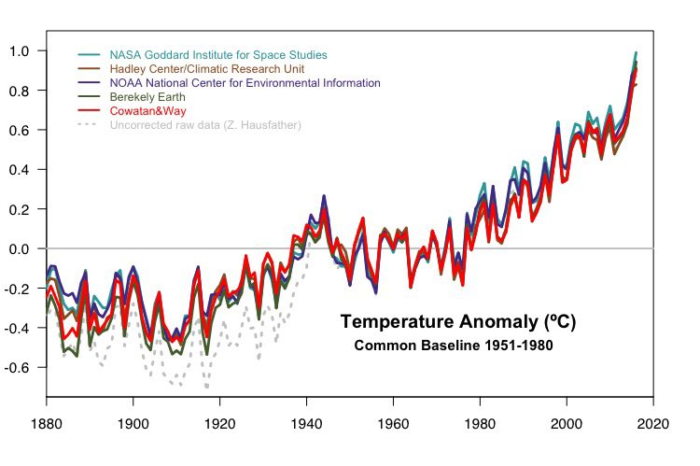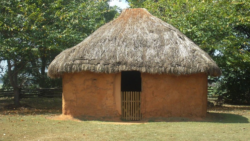Opening Questions
-What is the sustainability problem? How large, and how urgent?
-What is the connection of the problem to housing in the United States?
-How do we consider U.S. housing within the historical and global context?
-How is sustainability defined in the industry and for the purpose of this book?
-Why is this project important? What new understandings and directions revealed?
Introduction
2016 was the third record-breaking year in a row for rising global temperatures, and since humans began recording temperatures on earth, 16 of the hottest 17 years have occurred since 2000 (CNN, 2017). This graph shows global temperatures dating back to 1880, with a baseline drawn midway through the last century. When the baseline is set to pre-industrial levels, global temperatures in 2016 had increased 1.1 degree Celsius (1.98 degrees Fahrenheit); this is a significant amount toward the upper target of 1.5 degrees Celsius agreed to at the 2015 Paris Climate talks, a global conference convened to address this environmental crisis.
Why We Focused on Housing
Efforts are underway on many fronts to find more sustainable solutions, and this project is focused on residential housing, along with potential integration with transportation. In their publication on A Case for Climate Neutrality, the United Nations estimates that “buildings account for more than a third of energy used on the planet, and are in many countries the largest source of GHG emissions” (UNEP 2011). Buildings account for 39% of carbon dioxide emissions (the primary pollutant contributing to climate change) in the United States (EESI, 2017); in fact, emissions from buildings comprises a larger share of greenhouse gases (GHG) than from either industry or transportation, and it is projected to rise faster over the next 25 years than any other sector (EESI, 2017).
Housing and transportation in the U.S. are contributing enormously to climate change; the average American household contributes 48 tons of CO2e annually, broken down as 19 tons per person, and 2.53 people per household (Wilson, 2017). Our condition is urgent; humankind must act quickly to reduce CO2 emissions to sustainable levels, and yet the transition to climate-neutral buildings remains painfully slow. One of the most critical barriers to change is limited understanding of the long-term economic and ecological costs and benefits across all levels of the home building industry. Many homeowners, builders and architects are making decisions about design and construction that are not in the best interest of people today or in the future, and conventional wisdom appears to be slowing progress. The fantastic news is that a shift to sustainable housing is not difficult or costly, even while it seems counter-intuitive to the understandings and assumptions today.
Historical Sustainable Housing
The problem of building and living UNsustainably is relatively recent In the scope of human history. Climate change itself is a recent phenomenon, having occurred from human activity (anthropogenically) over just the last 175 years, and our collective understanding of it–and its potential impact–has emerged in just the last generation.
Sustainable housing is not a mystery; it was practiced by humans for thousands of years and is still practiced by many today. Historical evidence suggests that humans first used naturally occurring shelters, like caves, which placed no stress on natural cycles and ecosystems. Even after developing tools to mine resources, most civilizations built homes that we would consider sustainable by today’s standards. Ironically, it is low-income people today who continue to provide examples of simple, organic, and sustainable homes, like the rural East African home to the right.
These homes have two or three rooms, a mud floor, no plumbing or electricity, and no appliances, yet they provide the need for daily shelter. All of the resources employed for the structure are local, organic, renewable, and biodegradable; when abandoned, the structures return to earth naturally within a few years, and with no long-term damage. These basic homes exemplify near-zero environmental impact across the three life cycle phases of embodied energy from construction, operational energy through the useful life as shelter (except cooking), and finally demolition and disposal. Other examples of sustainable housing around the world, and through history, are igloos, teepees, earthen dugouts, and simple adobe homes, shown below.
Embodied, Operational, and Decommissioning Energy
There are three major phases to consider in the environmental impact of a residential home. The first is the energy and resources used for the construction process; this is often referred to as embodied energy, or embodied carbon. The second phase is the impact of operations; this is ongoing for the useful life of the structure and is largely dictated by lifestyle choices of the occupants. The third phase is the impact from demolition and discard, often referred to as decommissioning. By far, the largest environmental impact is from operations (Biswas, 2014); in fact, the Environmental and Energy Study Institute (EESI) documents that 70% of all electricity generated in the U.S. is consumed by building operations, and this represents the most significant component of climate emissions from buildings (EESI, 2017). There are interesting connections and tradeoffs between the three phases. For example, constructing a home for longer life and perhaps lower operational impact often requires more energy in both the construction and demolition phases. Minimizing impact in the initial construction phase in some cases results in higher operational impact and a shorter life span. A full life-cycle analysis spreads construction and decommissioning impacts across the number of service years; therefore, a shorter life span proportionally increases impacts from those two phases.
These tradeoffs are explored extensively over the next several chapters on solar energy and the building envelope, but a few assumptions and clarifications are helpful here. Virtually all local and state governments use building codes to ensure minimum standards for safety, health, and other consumer protections. Because of the cost and complexity of developing and maintaining such codes, most building departments in the U.S. “adopt nationally recognized model codes, often amending them to reflect local construction practices, climate and geography” (NAHB, 2017). Most are based on the set of standards maintained by the International Code Council (ICC), and broad adoption of this primary source provides fairly consistent minimum standards across the U.S. for structural integrity; this is often referred to as code-minimum or code-compliant. Houses built to code (minimum) are expected to last for an indefinite period (100+ years). Our experiences and expectations are congruent with this assumption if houses are designed to avoid moisture traps and subsequent structural compromise, if they are quality-constructed to code (typically verified by an independent building inspector), and if they are maintained effectively.
While the decommissioning phase has important environmental impacts, we won’t dwell on that aspect because we will assume an indefinite life with proper design, construction, and maintenance, and it is impossible to know of recycling possibilities that far into the future. If Americans continue building relatively large, permanent, and inorganic homes, which we expect they will, the environmental impact of the construction phase can only be reduced and not eliminated. Our primary focus, therefore, will be on reducing and eliminating phase two impacts from operations, while carefully considering tradeoffs with embodied energy and impact.
We recognize that a truly sustainable home also takes into account water conservation, local materials usage, and indoor environmental quality. While each of these is important and integral for a sustainable home, that is not the focus of our research. We will touch lightly on these issues, but will focus our attention and energy to developing a solution for a climate-neutral home that is affordable and attainable.
Sustainable housing is a broad notion and concept, and many terms and ideas have evolved to describe it. Some use this language to refer to goals of reducing, but not eliminating, negative environmental impact. Others work to achieve net-neutral impact over a period of time, often delineated annually or over the life cycle of the structure. The most aggressive approaches aim to be restorative, eliminating all common degradation elements of a home in operation, while also contributing positive externalities; this is sometimes referred to as net positive. Given our primary concern for operations as the largest impact phase, we will use the phrase, climate-neutral in operations, or climate-neutral for short, referring to a residence that cleanly generates as much or more of the energy it uses on an annual basis; in most cases this is achieved through clean, renewable, onsite power generation
Case Study
All three of us on the research team had a stake in the case study project. Hendricks was the architect on record, Beck the builder, and Leaman the homeowner. In this section we wish to provide some of the motivation that drove our quest to find sustainable housing solutions. Climate change is indiscriminate in its impact, creating problems for anyone in its path. However, what makes climate change one of the greatest social injustices in human history is that the poor, who are least complicit in contributing to the problem, often suffer the first and worst impacts, while they lack sufficient resources to adapt effectively. Meanwhile the affluent, those most responsible for causing the problem, are able to move, migrate, or invest in mitigation systems. A further injustice is that most of the anthropogenic contribution to climate change has come from people living in the relatively wealthy temperate zones of earth, especially in the United States, yet the equatorial regions are expected to confront the scourge of climate change both first and worst. We view these realities as an enormous environmental and social injustice, and working together on a new residential home offers the opportunity to test and critique new ideas, learn lessons from a real attempt at building a sustainable house, and create something that can be modeled for others to observe and learn from.
The chart to the right shows the carbon footprint of the average American, broken down by various categories of impact. It was our aim to build this case study house in a way that cuts the negative impact in half by eliminating most of the housing (red) and driving (blue) elements of the footprint. That would still fall well short of achieving a sustainable level of per capita climate emissions, but it’s the most that can be done from a housing perspective; the impacts of diet and consumption are beyond the scope of this project, though we invite readers to continue their investigations in those areas as well. This project is our way of responding to the great injustices of climate change!
Conclusions
Only 3% of houses had electricity by 1900 and it didn’t become common or widespread in U.S. homes until the 1930s (IER, 2014). The impact from residential living on the environment, and specifically on climate change, is very recent; yet today our buildings account for more than 39% of climate emissions. Addressing climate change, and other emerging environmental crises, will require a change of course in how we design, build, and operate homes. Action is urgently needed, but the path forward has not been clear. This book provides a viable paths to sustainable housing (and vehicle transportation), supported with data, analysis, and real case studies. Climate neutrality will be our primary sustainability objective, meaning a fully-functional home that adds nothing (net) to the climate change crisis. This study shows that climate neutrality can be achieved with reoriented priorities and careful planning rather than heavy financial investments; sustainable housing is affordable!
Do’s
-Learn about your impact on the fragile natural ecosystems of the Earth
-Do what you can to reduce your harmful impacts on the planet
-Begin crafting plans to make your home sustainable
-Learn about the environmental injustices
Don’t’s
-Don’t assume that building (or living in) a sustainable home is more expensive
-Don’t let the enormity of the problem discourage small individual steps
-Don’t allow the complexities of analysis lead to individual paralysis
-Don’t assume status quo is conventional (or good) wisdom
Check back for links to buy the book here!








